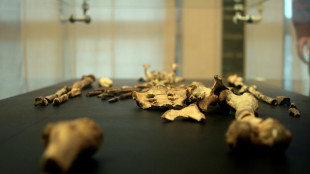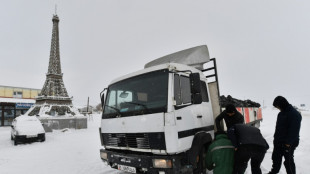
-
 Mbappe out for Real Madrid cup game as Ancelotti backs ref complaints
Mbappe out for Real Madrid cup game as Ancelotti backs ref complaints
-
AI regulation around the world

-
 Gut-Behrami tops downhill training, Vonn coasts
Gut-Behrami tops downhill training, Vonn coasts
-
Myanmar junta bans possible conscripts from foreign travel

-
 Israel commits to new Gaza talks ahead of Trump meeting
Israel commits to new Gaza talks ahead of Trump meeting
-
Tottenham defender Dragusin faces knee surgery

-
 Stocks rebound, dollar dips as Trump delay tariffs
Stocks rebound, dollar dips as Trump delay tariffs
-
England wing Murley out of France Six Nations clash

-
 Tequila maker Diageo axes sales target on Trump tariffs
Tequila maker Diageo axes sales target on Trump tariffs
-
Prague museum to host first European display of 3.18 million year old Lucy

-
 Where things stand in China-US trade tensions
Where things stand in China-US trade tensions
-
Japan's Olympic pool-sized sinkhole highlights risk of old pipes

-
 At Damascus opera house, hopes for a better future
At Damascus opera house, hopes for a better future
-
Double Olympic champion Gu out of Asian Winter Games with injury

-
 Frenchman on death row in Indonesia leaves jail ahead of transfer home
Frenchman on death row in Indonesia leaves jail ahead of transfer home
-
Japan PM to meet Trump on Feb 6-8 US trip

-
 Asian stocks and peso rise on Trump's Mexico, Canada tariff delay
Asian stocks and peso rise on Trump's Mexico, Canada tariff delay
-
Panama lawsuit requests axing Hong Kong firm's canal concession

-
 Nepal hikes Everest climbing fee by a third
Nepal hikes Everest climbing fee by a third
-
OpenAI chief Altman signs deal with South Korea's Kakao after DeepSeek upset

-
 UBS profit beats forecast as Credit Suisse merger nears end
UBS profit beats forecast as Credit Suisse merger nears end
-
Nintendo cuts net profit forecast as Switch sales slow

-
 Netanyahu to meet Trump as Israel, Hamas eye Gaza truce talks
Netanyahu to meet Trump as Israel, Hamas eye Gaza truce talks
-
China says to probe Google over anti-monopoly violations

-
 China slaps tariffs on US energy, vehicles in trade war sparring
China slaps tariffs on US energy, vehicles in trade war sparring
-
Frenchman on death row in Indonesia to return home

-
 Brunson scores 42 as Knicks bounce back, Thunder rout Bucks
Brunson scores 42 as Knicks bounce back, Thunder rout Bucks
-
China hits back at US with levies as Trump tariffs come in force

-
 Musk takes reins of US Treasury payments, sparking lawsuit
Musk takes reins of US Treasury payments, sparking lawsuit
-
DR Congo, Rwanda leaders to join summit on crisis in war-torn east

-
 Mahomes and Chiefs take on villain role as Super Bowl hype begins
Mahomes and Chiefs take on villain role as Super Bowl hype begins
-
OpenAI chief Altman inks deal with S. Korea's Kakao after DeepSeek upset

-
 Syria leader heads to Turkey to discuss rebuilding, Kurds
Syria leader heads to Turkey to discuss rebuilding, Kurds
-
Paris, the village of light in Kyrgyzstan's rugged mountains

-
 How China could respond to Trump's new tariffs
How China could respond to Trump's new tariffs
-
Trump to host Netanyahu for crucial Gaza ceasefire talks

-
 'Art for everyone': Mucha's masterpiece to find home in Prague, 100 years on
'Art for everyone': Mucha's masterpiece to find home in Prague, 100 years on
-
Trump halts Canada and Mexico tariffs, China still targeted

-
 Apple blasts porn app for iPhones in Europe
Apple blasts porn app for iPhones in Europe
-
Stocks and peso boosted by Trump's Mexico, Canada tariff delay

-
 France pitches AI summit as 'wake-up call' for Europe
France pitches AI summit as 'wake-up call' for Europe
-
Hundreds march in New York against Trump's trans policy

-
 Lindsey Vonn: World Ski Championships throwback
Lindsey Vonn: World Ski Championships throwback
-
Neymar homecoming is reminder of promise unfulfilled

-
 Eliasch offers 'hope' and big revenue growth for IOC's 'phenomenal brand'
Eliasch offers 'hope' and big revenue growth for IOC's 'phenomenal brand'
-
Attempted murder trial of Rushdie assailant to begin

-
 Musk's US government 'takeover' sounds alarm bells
Musk's US government 'takeover' sounds alarm bells
-
Ecuadoran drug gangs turn to death saint for protection

-
 Women players beat the odds to cut a path for ice hockey in Iran
Women players beat the odds to cut a path for ice hockey in Iran
-
In fire-ravaged Los Angeles, a long road of rebuilding


Japan's Olympic pool-sized sinkhole highlights risk of old pipes
A massive sinkhole near Tokyo that swallowed a truck and its driver a week ago, and has filled with sewage and debris, highlights the risk posed by Japan's ageing pipes.
Emergency workers have been striving in vain to reach the 74-year-old man, who rescuers have had no contact with for a week, and who was likely buried under sediment and sewage water in the sinkhole in the city of Yashio.
Officials say corroded sewerage pipes created the sinkhole that is now 40 metres (130 feet) wide -- nearly the size of an Olympic swimming pool -- and 15 metres (50 feet) deep.
Cranes have been mobilised and a 30-metre slope built to locate and reach the driver, with a second slope under construction, but progress has been slow and dangerous.
Koichi Yamamoto, an official with Yashio's fire department, told AFP on Tuesday that rescue efforts had been suspended.
A "substantial" amount of sewage water has accumulated at the site, eroding the surrounding soil and "constantly flowing in like a river", he said.
"This makes it impossible for us to proceed."
Also "hampering our rescue operation is a pile-up of heavy masses such as debris, slabs of asphalt and concrete that need removing", Yamamoto added.
When the hole suddenly opened up in Yashio, in the region of Saitama near Tokyo, during the morning rush hour on Tuesday last week, it at first looked like just one of thousands of sinkholes reported annually across Japan.
Their occurence is trending upwards in Japan, topping 10,000 in fiscal 2022, with many of the sinkholes sewage-related in urban areas, a land ministry probe shows.
- Ageing pipes -
Initially the hole was around five metres in diameter, then a much larger cavity opened nearby and the two holes merged.
To reduce the volume of sewage, locals were urged to "use as little water as possible" for three hours on Tuesday afternoon.
This was on top of requests already issued for about 1.2 milion people in Saitama to refrain from non-essential use of water, such as taking baths or doing laundry.
In response, some onsens have opened their public bath facilities for free to accommodate residents in Yashio and nearby areas, according to local media.
The week-long sinkhole saga was a reminder of the insidious corrosion gnawing at Japan's ageing water and sewerage pipes, Shinya Inazumi, a professor of geotechnical engineering at Shibaura Institute of Technology, told AFP.
The majority of the underground infrastructure was developed during the country's rapid post-war economic growth.
"Many sewerage pipes in Japan have already outlived their service life (of 50 years) so pipes anywhere else could break due to ageing," Inazumi said.
In just over 15 years' time, 40 percent of Japan's sewerage pipes will have exceeded their lifespan, according to an estimate from the land ministry.
In Yashio, local authorities attributed the initial chasm to rusty, punctured sewerage pipes that absorbed the surrounding soil, creating a hollow under the ground.
Extreme weather events such as intense rain -- made more frequent by climate change -- can also exacerbate this kind of infrastructure failure, Inazumi said.
"Rainfall these days can be extremely heavy and localised, which means a great amount of water seeps underground," the professor said.
"The water gushes in at an incredible speed, accelerating the growth of an underground hollow by making it bigger and bigger through erosion."
E.Flores--AT
